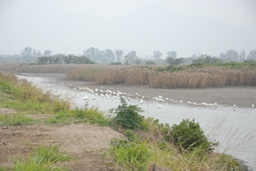Impact of glacial meltwater on phytoplankton biomass along the Western Antarctic Peninsula
Published in Earth & Environment and Ecology & Evolution

.jpg)
When we picture Antarctica, we often envision endless expanses of ice, frigid waters, and rugged glaciers. Yet, beneath this stark exterior lies a bustling ecological community, driven by microscopic phytoplankton -- tiny single-cell marine plants essential for sustaining Antarctic ecosystems (and that of the rest of the world). Our recent article in Communications Earth & Environment explores how these vital organisms respond to a rapidly changing Antarctic Peninsula, specifically due to increasing amounts of glacial meltwater. Here, I'd like to take you behind the scenes of our research, sharing the journey, challenges, and implications of our findings.
The story began several years ago during our field campaign along the Western Antarctic Peninsula (WAP) in 2015, a region experiencing dramatic environmental change. Witnessing firsthand the enormous size of glaciers and understanding the vital role these waters play in local fisheries and tourism spurred our curiosity. Could these melting glaciers, often perceived negatively, also benefit marine life by providing essential nutrients?
Together with a multidisciplinary team of researchers from institutions including NASA’s Jet Propulsion Laboratory, University of Colorado Boulder, Rutgers University, British Antarctic Survey, Scripps Institution of Oceanography, Alfred Wegener Institute, and Ocean Motion Technologies, Inc., we embarked on a journey to piece together two decades of data. We combined satellite observations, shipboard measurements, and reanalysis products to track glacial meltwater and its ecological impacts from 2002 to 2022.
One significant challenge was managing the diversity and sheer volume of datasets. Integrating satellite remote sensing data with field observations across multiple space and time scales required careful consideration and meticulous attention to detail. Moreover, Antarctic research often involves logistic hurdles, such as coordinating ship schedules, weather constraints, and ensuring safety in one of Earth's most extreme environments. Therefore, we are very grateful for all the hard work that our colleagues did to collect field data over the last twenty years which made this study possible.
Our efforts revealed a fascinating pattern: higher concentrations of glacial meltwater significantly correlated with increased phytoplankton abundance. Initially, we suspected meltwater primarily stabilized the upper ocean, providing ideal conditions for phytoplankton growth. Surprisingly, further analysis indicated nutrient fertilization, especially iron from glacier melt, played an even greater role. This discovery was crucial because iron is notoriously scarce yet vital for marine phytoplankton in Antarctic waters.
Notably, our findings showed that despite a stark decline in sea ice (a traditionally crucial source of nutrients and protection for marine ecosystems), glacial meltwater was partially offsetting this loss. This delicate balance underscores the complexity of ecological responses to changes in the environment.
Why does this matter beyond scientific curiosity? The WAP is home to a vibrant marine ecosystem that supports lucrative fisheries and a booming tourism industry, collectively worth billions of dollars annually -- these industries are there because of the animals that depend on phytoplankton. By unraveling the ecological roles of glacial meltwater, we provide valuable insights for resource management and conservation strategies that can sustain these industries amid rapid environmental changes.
Looking ahead, we’re eager to extend our research by incorporating data on phytoplankton community composition and its broader ecological impacts. This will help us better understand how different species respond to changing nutrient inputs and predict future shifts in Antarctic food webs.
Our study is just one step toward comprehending the full ecological consequences of Antarctica's changing environment. As the continent continues to warm, understanding these complex interactions becomes increasingly vital for preserving its delicate ecosystems and sustaining human activities that depend on them.
You can read the full paper here: https://www.nature.com/articles/s43247-025-02435-6
We invite you to explore this journey with us and consider the unseen yet significant connections between glaciers and life in the Antarctic seas.
Follow the Topic
-
Communications Earth & Environment

An open access journal from Nature Portfolio that publishes high-quality research, reviews and commentary in the Earth, environmental and planetary sciences.
Related Collections
With Collections, you can get published faster and increase your visibility.
Geology of the Moon
Publishing Model: Hybrid
Deadline: Jan 31, 2026
Drought
Publishing Model: Hybrid
Deadline: Dec 31, 2025





Please sign in or register for FREE
If you are a registered user on Research Communities by Springer Nature, please sign in